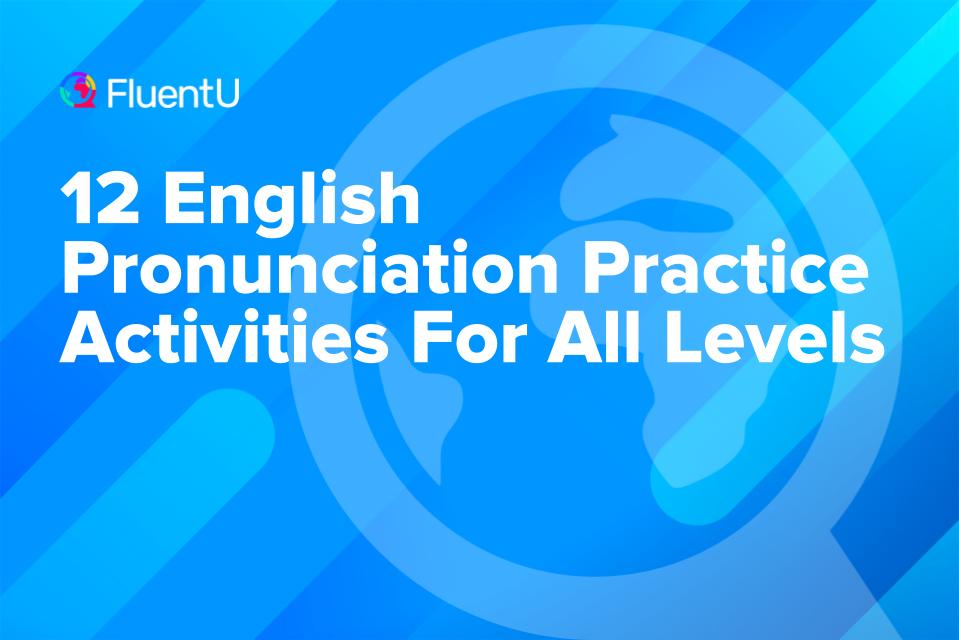Contents
- 1. Reverse Dictation
- 2. Act It Out
- 3. Minimal Pairs
- 4. Sound Mastery
- 5. Sing Along
- 6. Tongue Twisters
- 7. Where’s the Stress?
- 8. Your Day in a Haiku
- 9. Do-it-yourself Interview
- 10. Backchaining
- 11. Talk With an Object in Your Mouth
- 12. Watch Yourself in the Mirror
- Frequently Asked Questions About English Pronunciation Practice
- And One More Thing...
12 English Pronunciation Practice Activities For All Levels

It’s a common situation among English learners: You’re excited to practice your pronunciation, but there’s nobody you can talk to. But did you know you can actually do a lot of English pronunciation practice on your own?
These are my favorite activities to do when I don’t have anyone to practice my English with—I hope you’ll find them useful.
Download: This blog post is available as a convenient and portable PDF that you can take anywhere. Click here to get a copy. (Download)
1. Reverse Dictation
Goal: To check how easily understandable your pronunciation is
Phones are the ultimate gadget for studying. You can use your phone to review flashcards, check the dictionary and—yes—even to test your English pronunciation.
One way to do this is through reverse dictation. Dictation means to listen to someone speaking and then write down what they say.
Reverse dictation turns that around. This time, it’s you who has to speak—and your phone will be the one writing down what you say.
This is doable through the speech recognition feature, which is present in pretty much all modern phones. Here are the instructions for Android and iPhone.
You can then say simple sentences or even dictate a whole grocery list out loud! If your phone ends up misspelling a word, then most likely your pronunciation of that word is less clear. The beauty of this method is that you can repeat the sentence until your phone recognizes every word perfectly.
2. Act It Out
Goal: To pick up natural intonation and body language
English movies and TV series are some of the most fun learning materials you can use!
However, for this activity, you’ll be going beyond passive listening. Instead, you’ll have to pick a specific movie scene and give each line your full attention. To make it easier, turn on the subtitles.
Here’s a movie clip you can start with:
Listen closely to each line, then hit pause and repeat exactly how the actor said the line. There’s a little bit of acting involved! You won’t only be imitating the pronunciation but also the intonation and emotion behind the line.
To take your pronunciation practice even further, you can even try dubbing on the second pass. Put the clip on mute, then say each character’s line in real-time. Do your best to match your speech with their mouth movements.
3. Minimal Pairs
Goal: To clear up the confusion with similar sounds
Minimal pairs are two words in English that are almost the same except for one sound. It’s very common for English learners to get these words mixed up.
For example, most English learners (myself included!) have struggled at some point with minimal pairs such as reach vs. rich and feet vs. fit.
Here are some other examples:
- lot vs. rot
- sink vs. think
- pun vs. pan
To conquer minimal pairs, turn them into a sort of tongue twister or warm-up exercise.
Pick one to five minimal pairs. Say each pair repeatedly and as fast as you can while still maintaining proper pronunciation. You can do this every morning or whenever you start practicing your English.
This forces you to distinguish between the two words. The next time either word comes up in a conversation, you’ll be able to pronounce it much more accurately.
4. Sound Mastery
Goal: To focus on a single sound in English
Regardless of your level of proficiency in English, there might still be a few sounds that you’re having a hard time with. Usually, what makes these sounds so difficult is that you’re not used to pronouncing them.
To make these sounds more familiar, the key is repetition. Take one sound that you’re not as comfortable with and make a list of words with that sound. Then write down each word on an index card.
Then you should scatter these cards into places where you’ll see them every day. You might put one index card in your bathroom, another inside your wallet and a third one on your computer.
Whenever you see a card, say the word on the card out loud. Every time you encounter the words, you’ll get more and more confident with pronouncing the sound!
5. Sing Along
Goal: To practice connected speech
Choose a song that you like so much you could listen to it over and over. For example, I’m a fan of Michael Jackson songs, so I might start there.
Once you have a song, play it and listen for any connected speech. In English, words can sometimes flow into each other, as if there’s no space between them. The phrase fall in love has three words, but it’s often pronounced as “fallin love.”
This might not feel natural for you to do at first. But native English speakers do it all the time! It’s easier to notice and imitate connected words in songs, especially with the chorus.
Finally, sing along with the song while making sure that you’re also connecting your speech at the right places. In the song above, the phrases dream of you and miss a thing are examples of connected speech.
6. Tongue Twisters
Goal: To train your mouth to get used to English
Tongue twisters are one of the most time-tested pronunciation exercises around. After all, it’s not just language learners who use them. Tongue twisters show up frequently as party games, and public speakers often use them to prepare for speeches!
Many tongue twisters don’t make much sense in their meanings. That’s because the whole point of a tongue twister is the sound. Tongue twisters repeat the same sound in almost every word.
Here are some tough tongue twisters:
Frivolous fanciful Fannie fried fresh fish furiously.
How many snacks could a snack stacker stack, if a snack stacker snacked stacked snacks?
If two witches would watch two watches, which witch would watch which watch?
Say each tongue twister slowly at first, then speed up until you reach the fastest speed you can go!
For more of these, there are handy apps (Android and iPhone) that sort tongue twisters by level.
7. Where’s the Stress?
Goal: To get used to proper word stress
Whatever your native language is, there’s one part of English pronunciation that probably didn’t come naturally to you at first: word stress. This refers to the syllable in a word that’s emphasized (spoken the strongest or loudest).
Here’s word stress in action:
- blanket
- amazed
- psychology
Wrong word stress is one of the most common pronunciation mistakes people make. That’s not surprising considering how random word stress seems to be in English!
Here’s what you can do: Grab an English book or article that you can read and then pick a single paragraph. Look out for words with multiple syllables and mark the word stress in all of them.
Let’s take this sentence from “The Curious Incident of the Dog in the Night-time”:
I came home from school one day and no one answered the door, so I went and found the secret key that we keep under a flowerpot behind the kitchen door.
After you’ve marked the word stress on your own, check your dictionary to see if you got each word right. Then read each multisyllabic word out loud, exaggerating the stress. Finally, read the entire passage while keeping the proper word stress in mind!
8. Your Day in a Haiku
Goal: To hone your writing and pronunciation at the same time
Got 15 minutes to spare? This writing exercise doubles as a pronunciation exercise.
The basic idea is to write a quick poem in English about your day. There’s an extra rule, though: you have to write it as a haiku.
A haiku consists of three lines with five syllables in the first line, seven syllables in the second line and five again in the third line.
If you really enjoyed your breakfast, you might write:
I love my breakfast
Scrambled eggs, toast, sausages
Throw in ketchup, too
The results can get wacky! But you’re not done yet.
After writing your haiku, recite it in three different tones. You can do your normal voice first, then play around with different moods: monotone, singsong, happy, angry or whispering.
This will broaden your emotional range when talking in English so your speech will sound more natural.
9. Do-it-yourself Interview
Goal: To become comfortable with expressing yourself in English
One secret to improving your English pronunciation is talking to yourself. And not just in your head, either—I mean talking out loud!
To turn it into a daily practice, make your own little recordings. Each day, answer a specific question in English for two minutes while recording yourself on your phone.
The questions should get you talking about your life, like these:
- How have you changed since last year?
- If you could meet one historical person, who would it be?
- What’s a joke or meme that you recently laughed about?
No need to even come up with them yourself! There are plenty of question lists available online (and yes, these are the same questions people ask at parties or when they want to get to know someone better).
After recording yourself, take a break for at least five minutes to refresh your mind. Then play back the recording and observe how it sounds.
Are there words you’re having trouble with? Did you pause halfway through because you weren’t sure how to express yourself? Write these down as a list of things to work on for your next pronunciation practice.
10. Backchaining
Goal: To smooth out word beginnings and endings
Certain word beginnings and endings in English can be hard to pronounce, especially if they’re not in your native language. For example, some English learners struggle with “s” at the start of a word (school, snake), while others struggle with words ending in consonants (pan, scientist).
If you can relate to this, you can try a more targeted pronunciation exercise: backchaining.
Backchaining is constructing a sentence backwards. You start with the last word, then add the second to the last word and so on until you form the whole sentence.
Here’s how it works:
bucket — the bucket — dropped the bucket — accidentally dropped the bucket — I accidentally dropped the bucket.
You can even do this for individual words: n — an — pan.
This exercise can be very helpful because it forces you to isolate specific sounds and words.
For an added challenge, tell a story while backchaining! Go for at least three sentences. It’s a bit of a mind-bender and you can end up talking about funny scenarios.
11. Talk With an Object in Your Mouth
Goal: To practice speaking clearly
If you’re struggling with pronouncing your words clearly, then try using this simple pen trick.
Just grab a pen or pencil, and put it in your mouth between your teeth. Then, start speaking! You can talk without a script, or use a passage of writing such as an article or page from a book
You’ll need to put much more effort into speaking because the pen will be in the way, forcing you to think about how you are pronouncing certain words.
Then, take the pen out of your mouth, and repeat what you just said. It should be much easier this time as the pen is no longer in the way, and there’s a good chance you’ll hear an improvement in your pronunciation.
You also don’t have to use a pen or pencil. You could also try an object like a cork, as suggested by Accent’s Way English with Hadar.
12. Watch Yourself in the Mirror
Goal: To make sure your mouth and tongue are in the correct position
A great way to improve your pronunciation is to watch yourself in the mirror while you talk, to see the shape of your mouth and tongue. Compare the way you’re moving your mouth to the way that native speakers move their mouths, to see where you might be going wrong.
Make sure to watch videos that are close to the mouth of the speaker so you can see the smaller details. This playlist from BBC Learning English is a good example.
Watch the video, and try your best to copy the exact position of their mouth while looking in the mirror to see if it matches. You can pause the video to make this process easier while you look between the mirror and the screen.
By making adjustments to your mouth shape or tongue placement, you can make your pronunciation clearer, and more natural.
Frequently Asked Questions About English Pronunciation Practice
How Can I Improve My English Pronunciation?
Practice makes perfect, so the best way you can improve your pronunciation in English is to practice consistently. The activities above are a great way to train your mouth to produce the correct sounds, and with enough practice it will become like second nature.
Listening to a lot of authentic English content is also important for learning how the language sounds in different regions. The more you listen, the more you will feel able to reproduce these sounds.
To learn with media such as film clips, inspiring talks, music videos and more, FluentU could be helpful.
FluentU takes authentic videos—like music videos, movie trailers, news and inspiring talks—and turns them into personalized language learning lessons.
You can try FluentU for free for 2 weeks. Check out the website or download the iOS app or Android app.
P.S. Click here to take advantage of our current sale! (Expires at the end of this month.)

You can also head over to our YouTube channel for more lessons based on popular English media:
How Can I Improve My American Accent in English?
To improve in any accent of English, such as American, it’s important to surround yourself with that accent as much as possible. This means, in the case of the American accent, watching American TV shows, talking to American people, and learning from American teachers.
If you want to learn more about how to perfect your American accent, with details of specific aspects of pronunciation, check out this handy guide!
You get the best results when you can do some English pronunciation practice every day. Luckily, you won’t always need a conversation partner for this! With the solo exercises above, you can work toward becoming an excellent English speaker whether you’re alone or with other people.
And One More Thing...
If you like learning English through movies and online media, you should also check out FluentU. FluentU lets you learn English from popular talk shows, catchy music videos and funny commercials, as you can see here:
The FluentU app and website makes it really easy to watch English videos. There are captions that are interactive. That means you can tap on any word to see an image, definition, and useful examples.
For example, when you tap on the word "searching," you see this:
Learn all the vocabulary in any video with quizzes. Swipe left or right to see more examples for the word you’re learning.

FluentU helps you learn fast with useful questions and multiple examples. Learn more.
The best part? FluentU remembers the vocabulary that you’re learning. It gives you extra practice with difficult words—and reminds you when it’s time to review what you’ve learned. You have a truly personalized experience.
Start using the FluentU website on your computer or tablet or, better yet, download the FluentU app from the iTunes or Google Play store. Click here to take advantage of our current sale! (Expires at the end of this month.)










